Walking in the outdoors is a powerful tool for helping improve both our physical and mental health. Over the past few years, innumerable surveys by health charities and scientists have revealed that spending time in green spaces for exercise has a positive impact on mental wellbeing, increasing levels of self-esteem and decreasing feelings of depression.
Walking is good for us, it allows us to connect our bodies and minds, and makes us feel more in tune with the landscape – and the world – around us. Walking brings us closer to nature, builds perspective and offers an escape from the busy lives that so many of us live.
Often the hardest part of a walk is choosing one in the first place; one that suits you. So we've created a guide to get you started: 40 great walks for mindfulness and wellbeing.
We've divided the walks into three sections: nature trails, walks for perspective, and great escapes. Each route includes a map and walk directions, providing you with everything you need to get outside and get walking.

Best nature walks for wellbeing
Bystock Nature Reserve, Devon
6 miles | 3.5 hours | easy-moderate
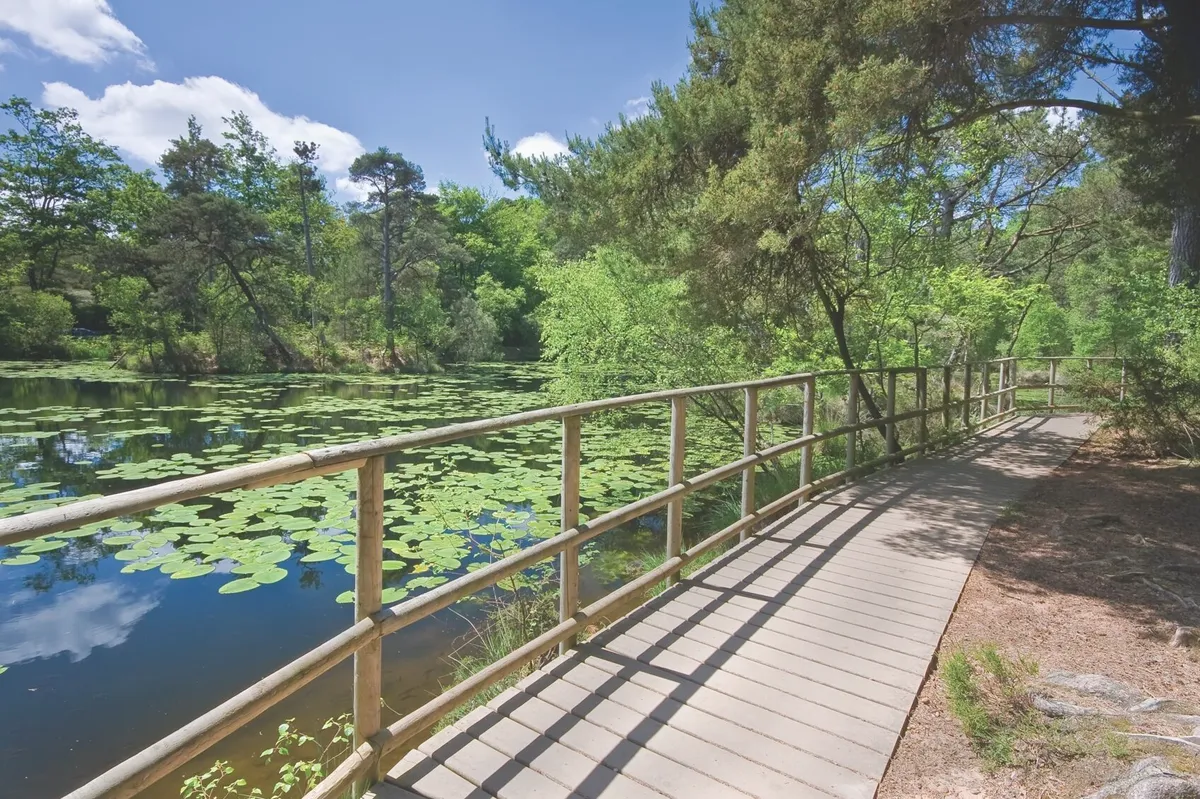
Bystock Nature Reserve and its mosaic of lily ponds, heaths and open meadows sits on the doorstep of the Jurassic Coast. Of the 50 reserves managed by Devon Wildlife Trust, it remains a firm favourite among visitors and Devonians alike.
Explore the heart of this wild reserve, take a stroll through the picturesque village of East Budleigh, and then end the day with a view of adventurer and writer Sir Walter Raleigh’s birthplace.
Bystock Nature Reserve walking route and map
Coille Mhòr, Highland
5 miles | 3 hours | moderate

Coille Mhòr – the great wood – is a haven for beautiful flowers. In May, bluebells grow beneath the tree canopies and alongside the distinctive bluish-purple petals of common dog violet.
The zing of late spring and early summer is powerful here. Pure air provides ideal conditions for an impressive range of lichens that grow en masse upon the old oaks of Coille Mhòr’s lower slopes. Higher up, birch, rowan, alder and ash thrive, and the forest is also home to mammals including badgers, pine martens and visiting otters.
A there-and-back-again walk from Balmacara Square car park leads uphill through the pointed green leaves of grass of Parnassus to Loch Achaidh na h-Inich, where the bright sulphur-yellow flowers of bog asphodel bloom in late summer.
Coille Mhòr walking route and map
Muker, North Yorkshire
6.8 miles | 4 hours | moderate
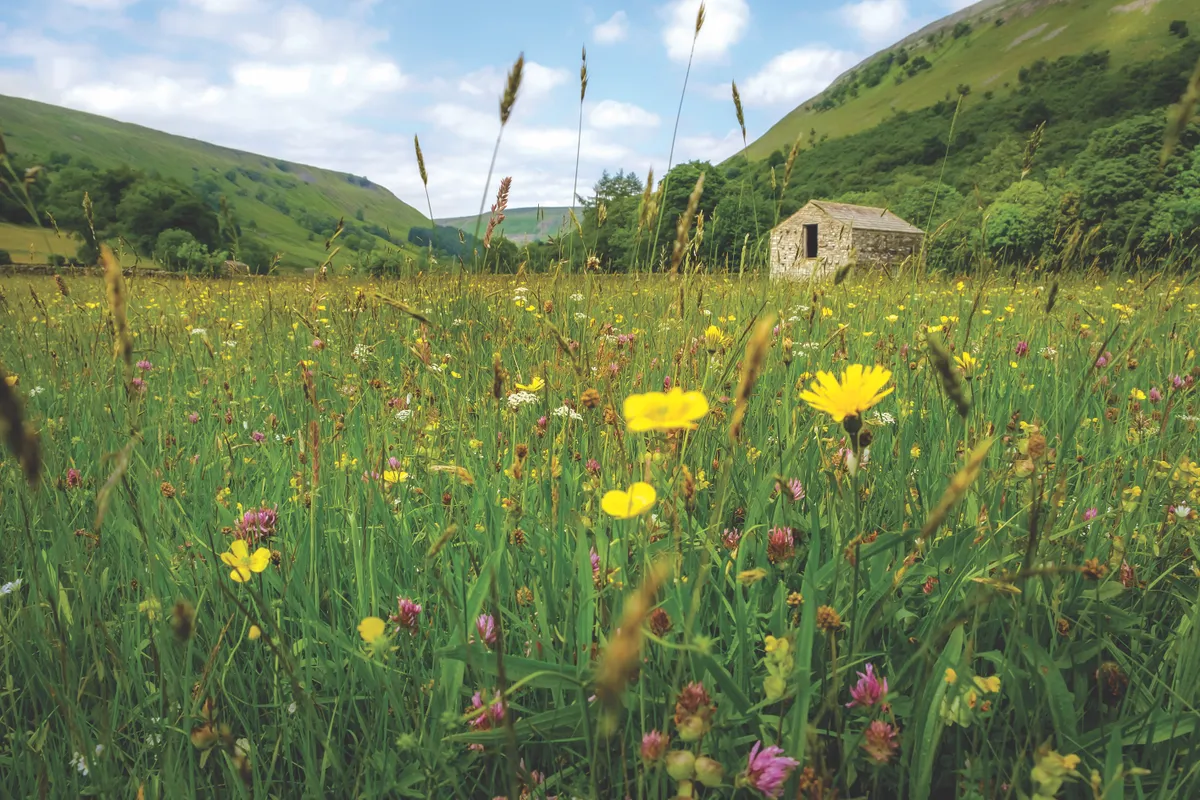
The species-rich hay meadows that surround the village of Muker are internationally important – the site is so significant, in fact, that it is now protected as a SSSI.
Late spring and summer are the optimum times to visit if you want to make the most of this flower spectacular, where crosswort, melancholy thistle and yellow rattle are complemented by screaming swifts, zipping swallows and burbling curlews. Get down on your belly to gain a flower-level view of this wonderful carpet, before enjoying a peaceful river ramble through classic Dales landscape.
Ramsey Island, Pembrokeshire
2.6 miles | 1.5 hours | easy

St Justinian the hermit sought sanctuary on Ramsey in the 6th century and, if it’s peaceful solitude you’re after, this secluded outcrop is still the perfect place to find it.
Ramsey is also a haven for wildlife. In June, breeding seabird colonies are in full swing with razorbills, guillemots and gulls crowding the narrow, rocky ledges. Choughs display their acrobatic aerial abilities on the cliff-top updraughts. Grey seals and harbour porpoises can be glimpsed in the bays below and, throughout the spring and summer, maritime plants and heather cover much of the island in a rich carpet of colour.
A well-signed route (which can be walked as two shorter trails) makes an almost-complete circuit of the island.
Ramsey Island walking route and map
RSPB Arne, Dorset
4 miles | 2 hours | easy
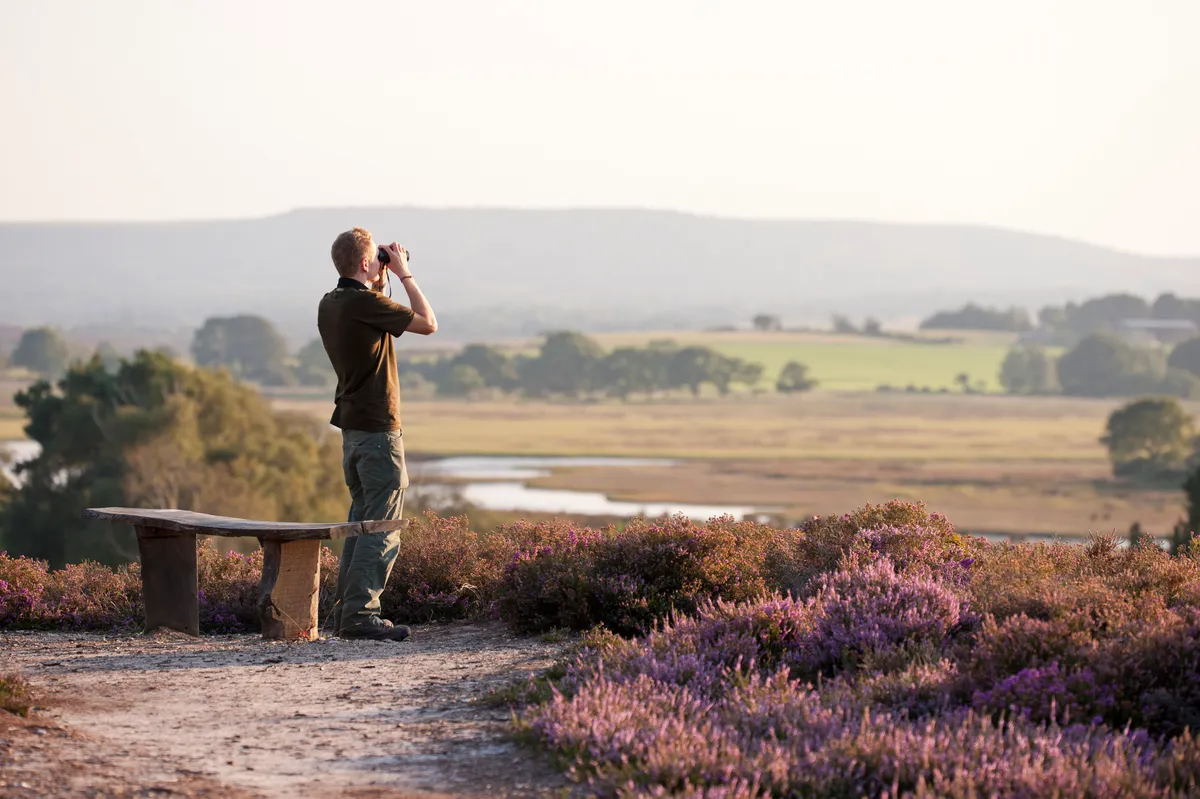
This wildlife-rich heathland – jutting into the shallow expanse of Poole Harbour – supports all six species of native reptile and around 50 pairs of nightjar. An easy birder’s walk around Arne begins in the car park, where siskins, tits and great spotted woodpeckers feed beside the information hut. Avocets flock in their hundreds in winter, and can be seen from the Combe Heath bird hide, alongside black-tailed godwits and striking spoonbills.
RSPB Arne walking route and map
Craig Cerrig-gleisiad, Powys
2.7 miles | 2 hours | moderate–challenging
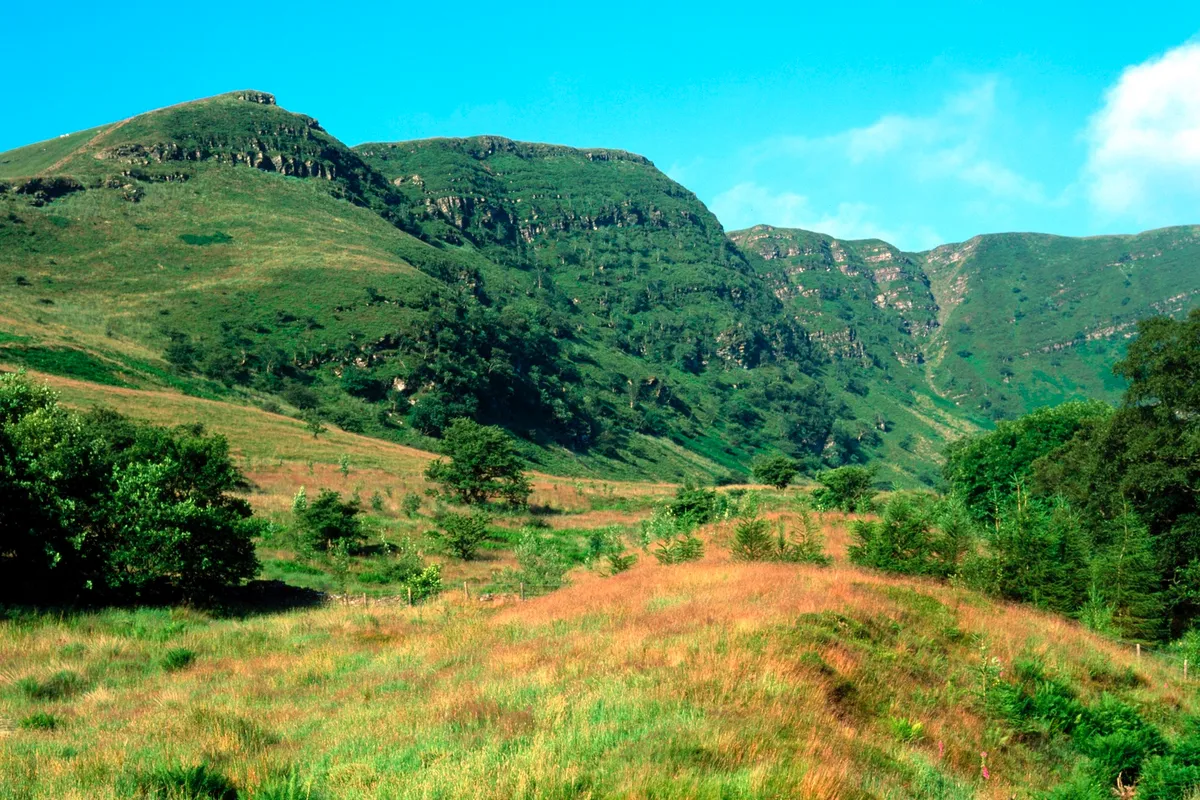
The raven-haunted buttress of Craig Cerrig-gleisiad is studded with steep crags that have prevented sheep from grazing rare sub-alpine plants, such as the delightful purple saxifrage. It means that the flora here is richer and more interesting than anywhere else in the Brecon Beacons National Park.
At the foot of the cliff in spring you’ll find bluebells flowering among the hawthorn scrub. As you climb the steep paths to the top, look out for nesting peregrine falcons and the star of the reserve, the ring ouzel.
Enjoy a superb 4.4km walk through the reserve, starting and finishing at a layby on the western side of the A470
Craig Cerrig-gleisiad walking route and map
Blackhall Rocks, Co Durham
3 miles | 2 hours | easy
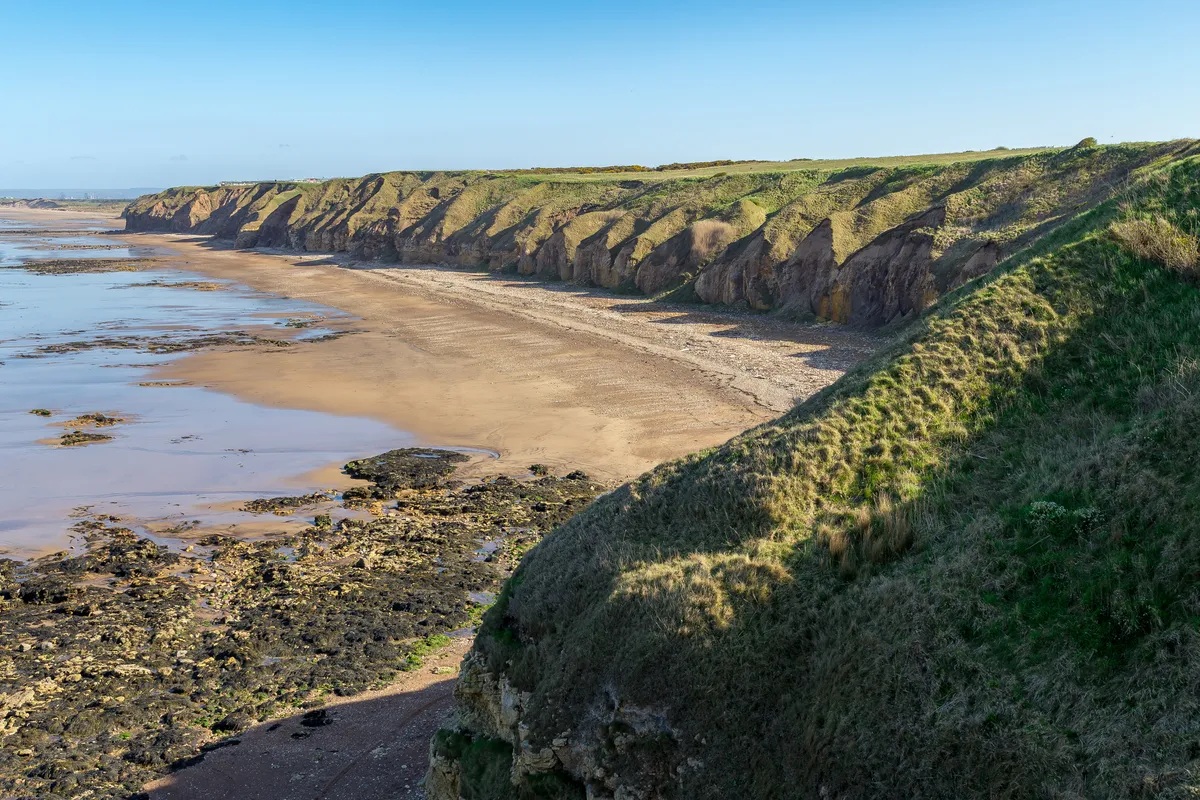
The 1980s saw the closure of Blackhall Colliery and a clean-up of the then filthy beach, which has since become part of the Durham Coast National Nature Reserve.
The rocks here are magnesian limestone, laid down by a shallow sea 250 million years ago as it washed over carboniferous deposits. The soils that formed above the rock encourage an abundance of flowers that adorn the cliffs during spring and summer, and attract many butterflies, including the rare brown argus.
Along the coast at the base of a small dene is a shallow brackish pool fed by springs from the limestone. Wading birds often leave their footprints in the mud at its edges. Explore this reclaimed coast on a three-mile circular hike along the County Durham coast, passing beaches, caves and shoreline denes.
Blackhall Rocks walking route and map
Chobham Common, Surrey
5 miles | 3 hours | easy-moderate
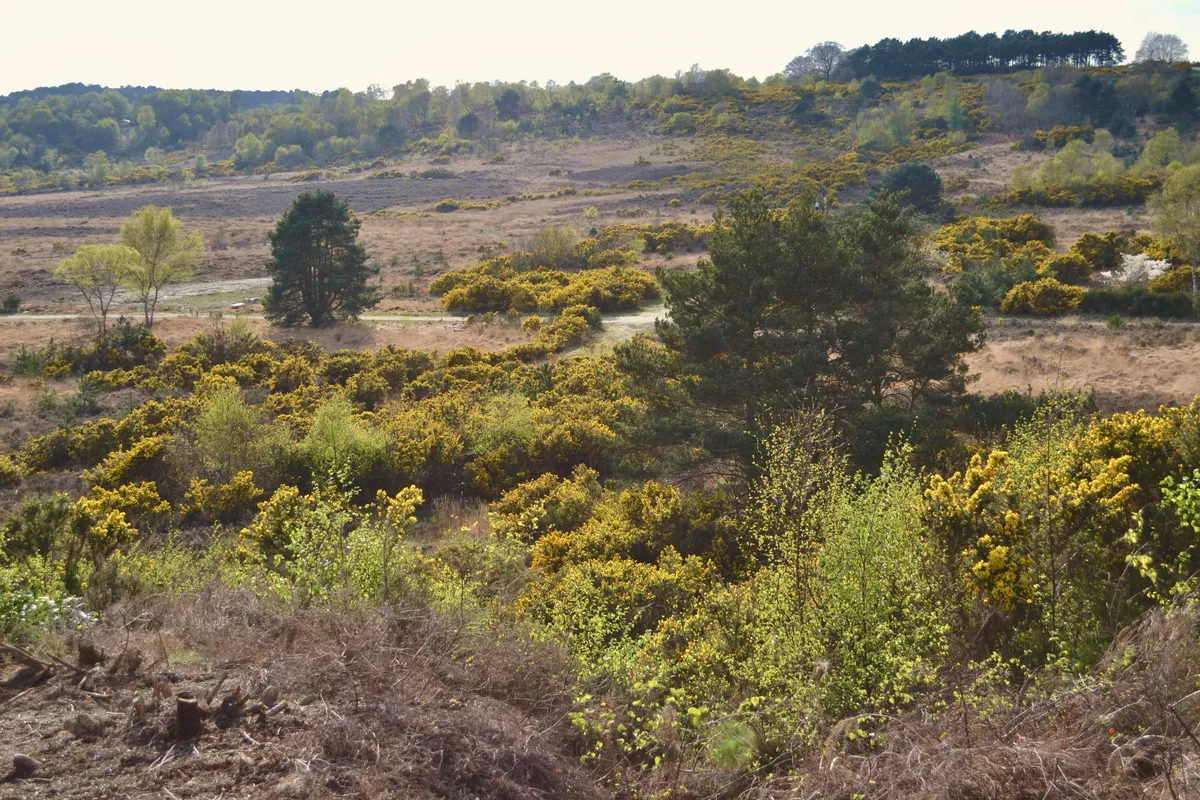
Chobham Common luxuriates in the honour of being the largest national nature reserve in south-east England.
Tread lightly on this flat nature trail and you may see adders sunning themselves on piles of dead leaves or in patches of bare sand. There are three species of heather at Chobham: common heather, or ling; cross-leaved heath; and bell heather. In the quagmires you may spot the bizarre insect-trapping sundews that glisten in the morning sun. Come back in July and try to find the purple trumpets of marsh gentian, now extremely rare in Surrey. And be on the lookout for Britain’s largest moth, the emperor.
Chobham Common walking route and map
Glencoe Lochan, Highland
2 miles | 1 hour | easy
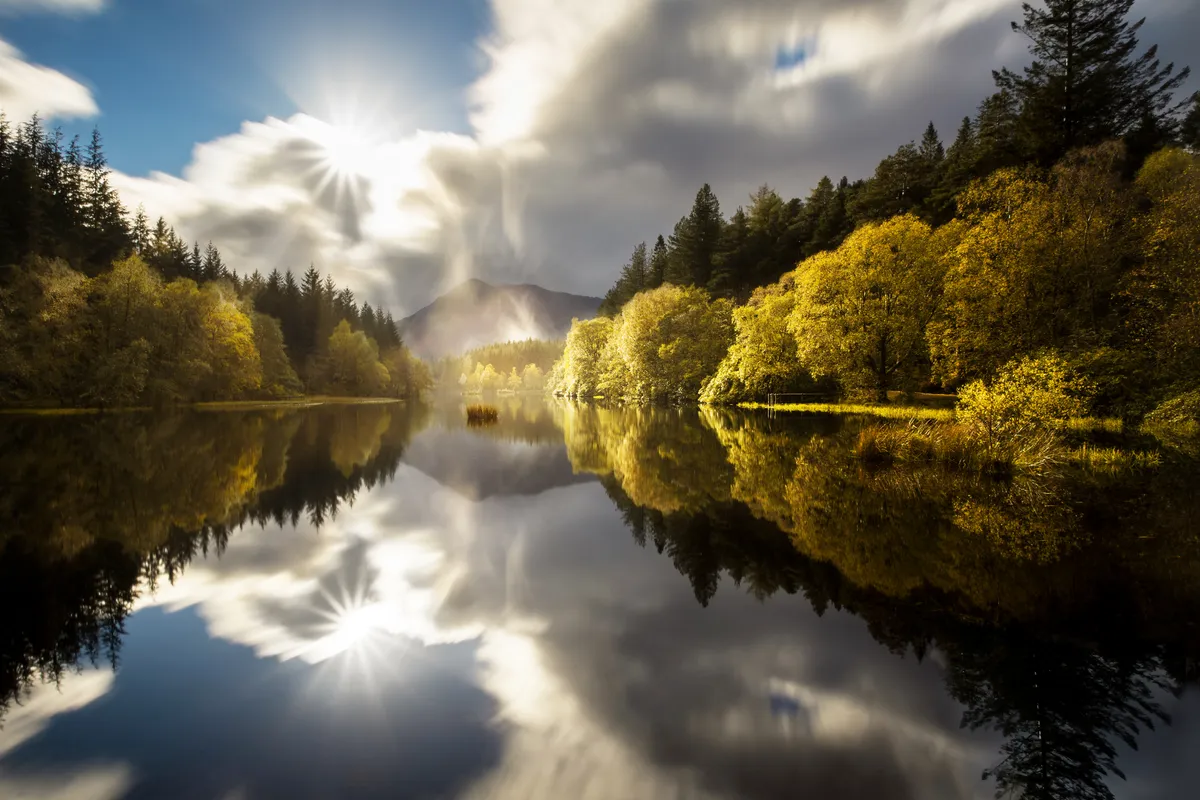
The marauding peaks that surround the deep cleft of Glen Coe may be a step to far for many of us, but a number of enjoyable, low-level routes offer a more docile way to experience the majesty of this landscape. Perhaps the best is a walk around gorgeous Glencoe Lochan, which starts in attractive woodland where you can spot red squirrels, crested tits and perhaps a pine marten.
Many of the conifers that punctuate the woodland around Glencoe Lochan were planted in 1895 by Lord Strathcona, who was born in Scotland but emigrated to Canada at the age of 18. He returned several years later with his Canadian wife, Isabella, and they acquired Glencoe Estate, but Isabella felt homesick. Her husband tried his best to recreate the Canadian forest environment by planting a large number of trees in order for his wife to feel at home.
Unfortunately the plan didn't work and they both eventually returned to Canada, leaving behind a beautiful woodland legacy. Listen for the rat-tat-tat of woodpeckers, the calls of tawny owls or the rustle of undergrowth from a startled roe deer as you walk through the trees.
Glencoe Lochan walking route and map
Brandon Reach, Warwickshire
4 miles | 2.5 hours | moderate
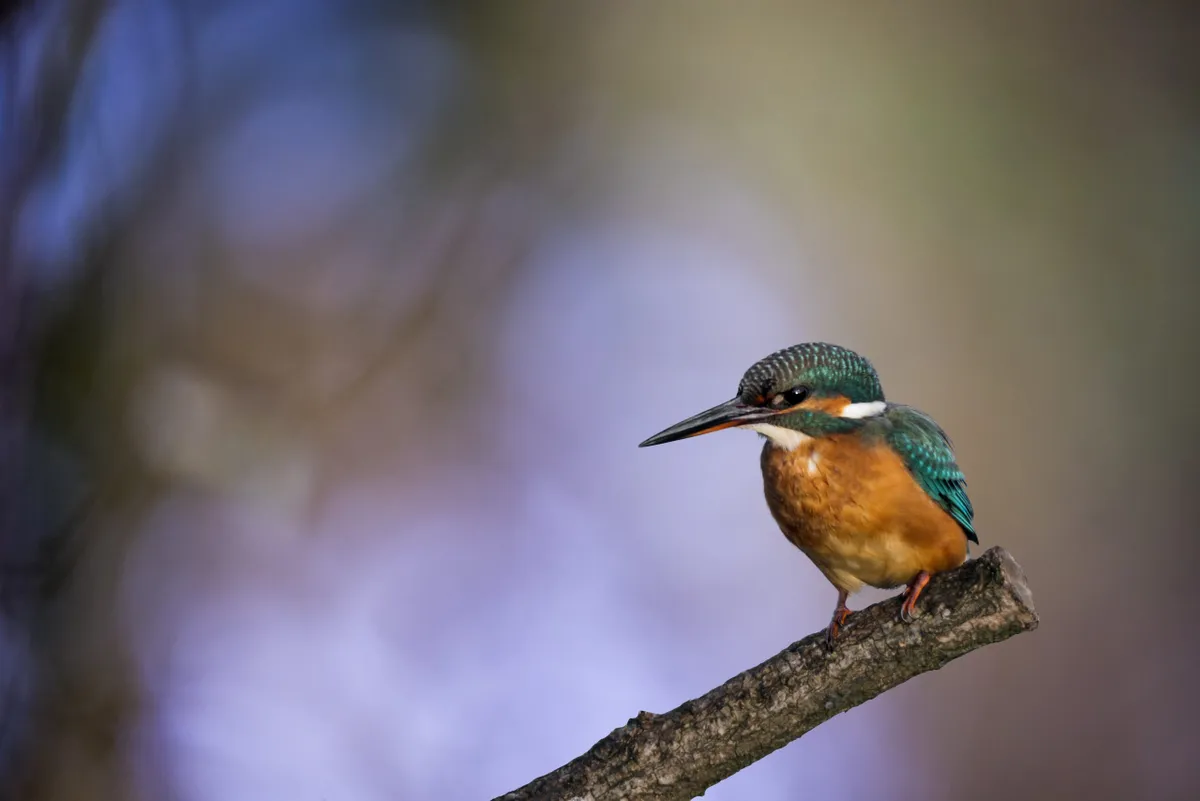
Forty years after developing the glorious Brandon Marsh Nature Reserve on the edge of Coventry, Warwickshire Wildlife Trust had an opportunity to double its wilderness, and acquired Brandon Reach. Now larger than London’s Hyde Park, the two reserves reach out towards the town, connecting local communities with a rich oasis of nature. With a history of mixed land use, the grassland, scrub and ancient woodland at Brandon Reach offer a sense of escapism and peace rarely felt so close to major urban infrastructure.
Starting at Brandon Marsh Visitor Centre, wander across wild grassland on seldom-trodden pathways through to Piles Coppice before rewarding yourself with a steaming brew back at Badger’s Tearoom.
Brandon Reach walking route and map
Sutton Park, West Midlands
1.7 miles | 1 hour | easy
Sutton Park is a miraculous survival – 2,400 acres of wild country just six miles north of the bustling heart of the UK’s Second City, Birmingham.
The ancient oak and birch woodlands are alive with birdsong in spring, and in the vast holly understory, one of the park’s great specialities, the delicate little azure-winged holly blue butterfly, takes to the wing. On the largest of the seven lakes, great crested grebes, goldeneyes and tufted ducks have made a home.
To get a taste of Sutton Park, take the short Bridges Walk, navigating the shores of Bracebridge and Little Bracebridge Pools.
Sutton Park walking route and map
Glenariff Forest Park, Co Antrim
1.5 miles | 1 hour | easy
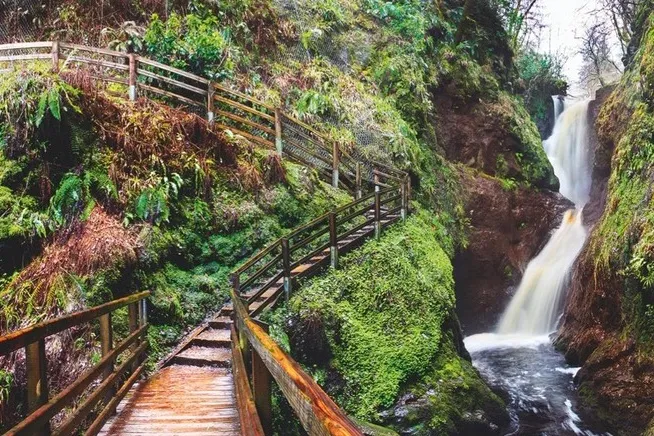
The Glenariff and Inver rivers have cut right through this spectacular steep-sided gorge – the Queen of the Glens. These rivers can be lively and dramatic as they tumble over boulders in a series of three impressive waterfalls. But then they become suddenly calm and tranquil, flowing lazily through oak and beech woodland, sunlight streaming through the fresh leaves.
An easy-to-follow trail along specially designed walkways, slaloms through this humid and moist microclimate, where rare ferns, mosses and liverworts grown among spruce, fir, pine and larch.
Glenariff walking route and map
Best walks for escapism
Slieve Binnian, County Down
6 miles | 4.5 hours | challenging
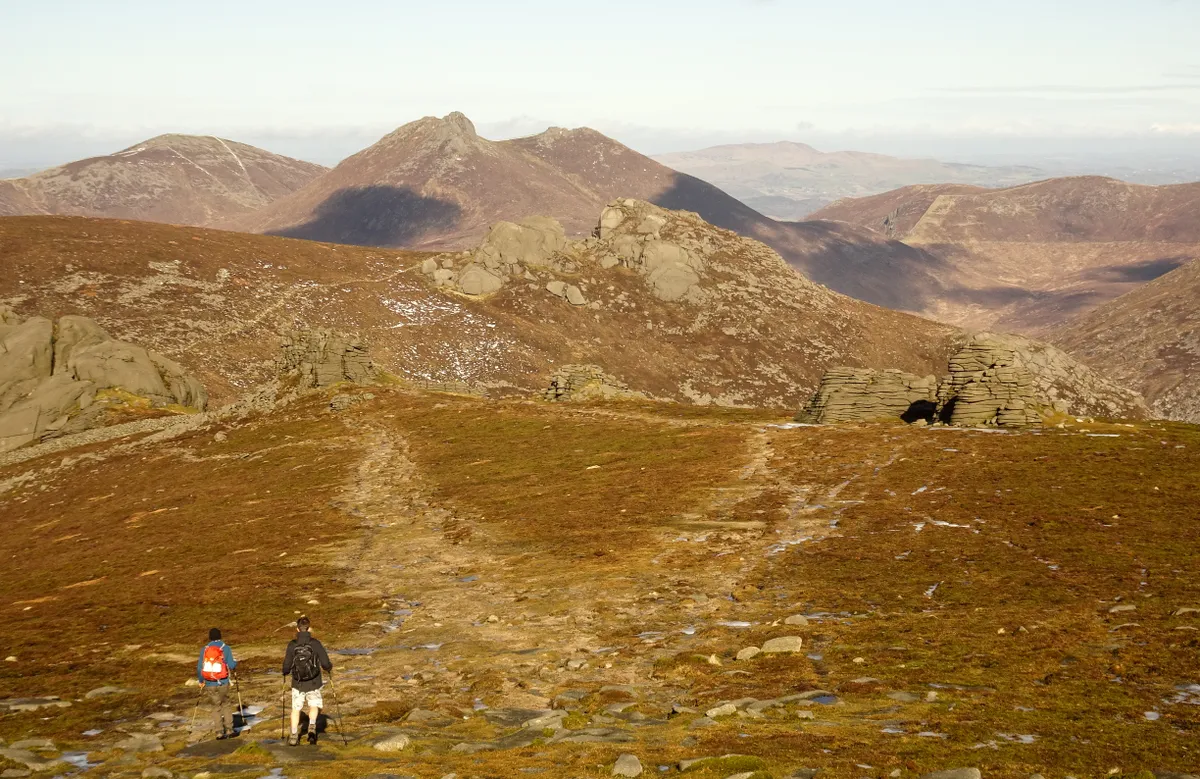
Northern Ireland’s Mourne Mountains were created in midst of a deep winter. The entire range owes its form to the scouring movements of vast ice sheets, which only began to melt some 13,000 years ago.
Yet not all the peaks were covered by ice; the very highest summits protruded above the frozen wasteland. Slieve Binnian was one such landmark, and the massive, frost-shattered tors that erupt from its tip were once nunataks, lonely towers of rock that withstood the elements above the icy expanse.
The walk that lets you explore all this is just four hours long, but involves 600m of ascent, so demands hillwalking experience and mountain equipment, such as walking poles, as a prerequisite. Route-finding is not overly tricky, but it’s best to wait for a clear day to make the most of the fabulous views. And having completed the route, it’s just a short drive down to the pubs in Annalong, where you can recount your adventures over a hot meal and a pint.
Slieve Binnian walking route and map
Loch an Eilein, Highland
3 miles | 1.5 hours | easy
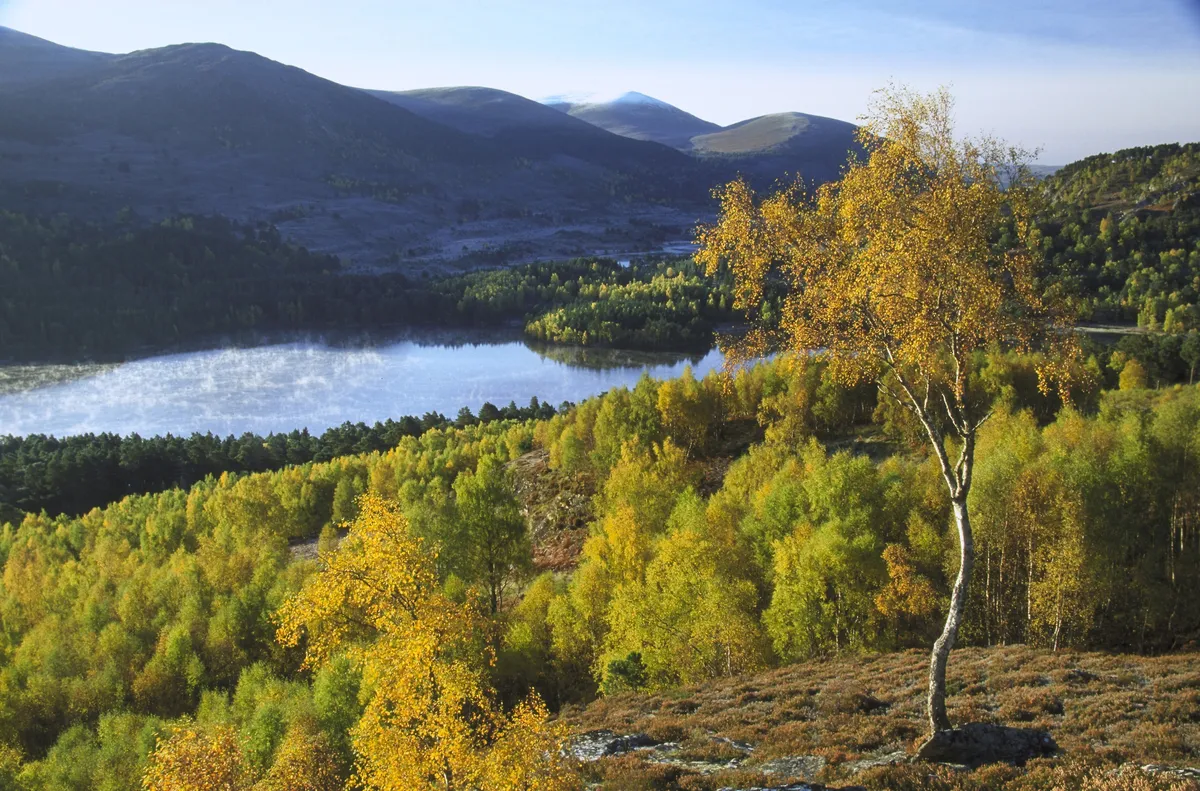
The Highland town of Aviemore is one of the great adventure towns of Britain. With its choice of hip or traditional bars, and swish wooden cabins, it is the ideal base for a foray around the northern fringes of the Cairngorms National Park, and one of its most beautiful lochs.
Encircled by mature Scots pine, Loch an Eilein is, for many, the finest short walk in the country. Yet what this level, three-mile route lacks in distance it more than makes up for in atmosphere; the surrounding tundra-like plateaux, ancient Caledonian forest and soaring golden eagles make you feel like you’re in the Arctic.
Nearby Loch Morlich and its short waterside trail offers another opportunity to experience this Highland paradise.
Loch an Eilein walking route and map
Holkham, Norfolk
4.8 miles | 3 hours | easy/moderate
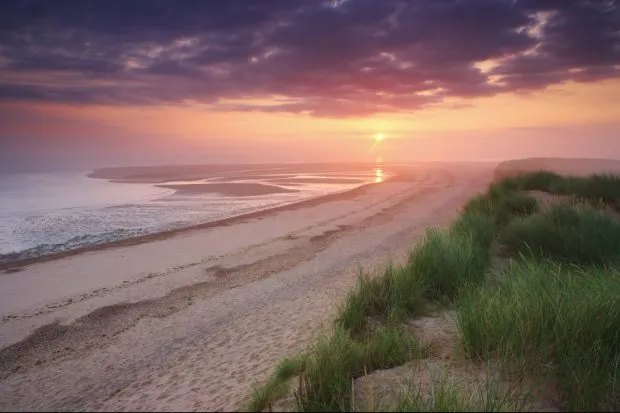
It is said that in Norfolk you can tell how far you are from the coast by the roundness of the flint on the outside of the buildings – the rounder the flint, the closer you are to the sea. The interaction between sea and land is strong along this wild section of coast, where mudflats and salt marshes sit alongside miles of empty beaches.
Step out of a wind-wrapped pinewood on the North Norfolk coast onto the vast sands and tidal lakes of Holkham beach. The shoreline is part of one of the largest national nature reserves in the country, home to many rare species of flora and fauna and a favoured place for birdwatching. This walk is for both nature-lovers and those looking for the harmony offered by seemingly endless beaches, seas and skies.
Handa Island, Sutherland
4 miles | 3 hours | easy-moderate
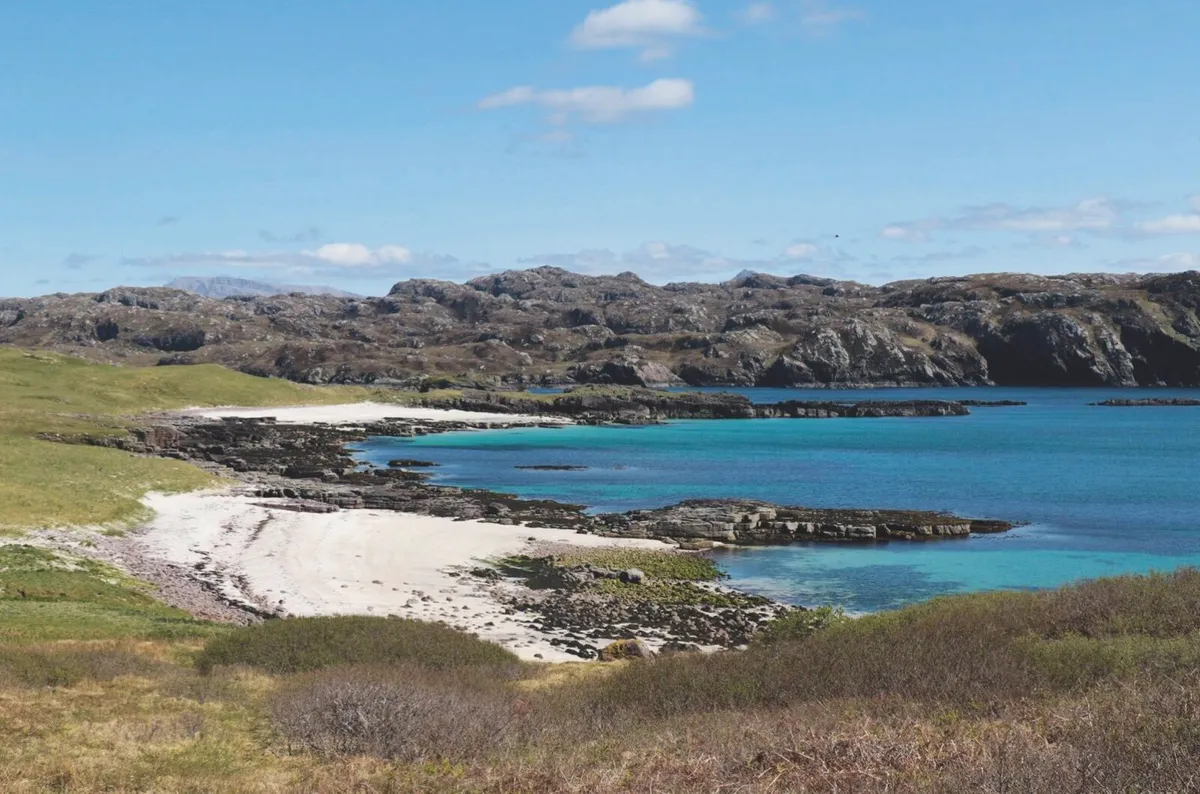
Wrapped by brutish Atlantic swells and biting winds, this remote island off the west coast of Scotland makes for harsh living. But in spring and summer, enduring these forces is one of north-west Europe’s largest seabird colonies; 100,000 breeding seabirds, including guillemots, razorbills, kittiwakes, puffins, fulmars and Arctic terns.
In the warmer months, a small passenger ferry runs daily from Tarbet on the mainland across the Sound of Handa (look out for minke whales, basking sharks, common and grey seals) to the ivory-white beaches of Port an Eilean and Traigh an Teampaill on the island’s eastern shores – the perfect starting point for a circular walk around the island.
Scourie, a few miles south of Tarbet on the mainland, has a campsite and indoor accommodation, offering visitors a quiet base from which to explore this remote section of the Scottish coast.
Handa Island walking route and map
Harlech and Moel Goedog, Gwynedd
9.5 miles | 5-6 hours | moderate
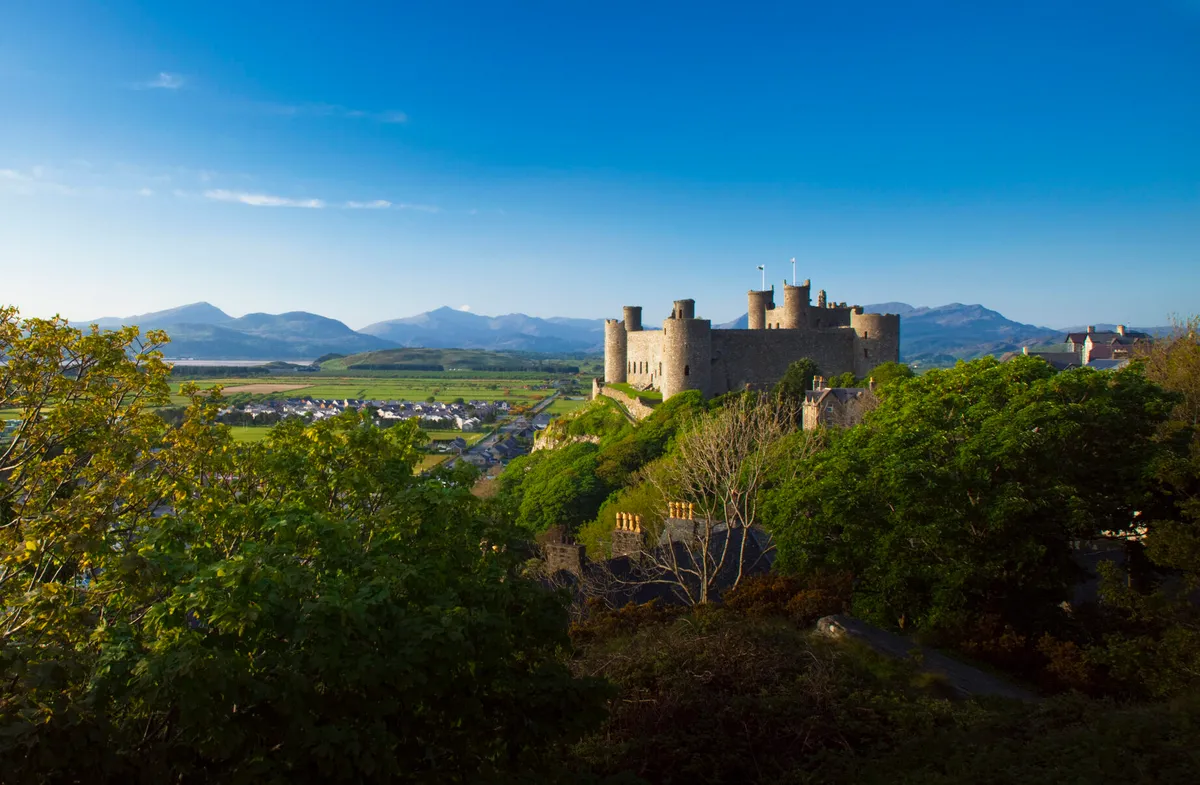
Located in the ancient district of Ardudwy, between the stunning estuaries of the Mawddach and Glaslyn, is the town of Harlech, famed for its dramatically positioned castle on a rock. Superb views stride out from the medieval fortress over a shimmering sea to the rocky hills of the Llŷn Peninsula and the lofty peaks of Snowdonia.
High above the castle and town, a Bronze Age trackway runs through a magical landscape, disturbed only by Cader Faner, a striking Bronze Age cairn set in the wild foothills of the Rhinog mountains. After your walk through history, return by more modern means on the bus or train (or join Wales Coast Path) from Llandecwyn back to Harlech, where ample lodgings and refreshments await.
Harlech and Moel Goedog walking route and map
Langdon Beck, County Durham
7.5 miles | 4 hours | moderate
Conkley Scar, Falcon Clints, Whiddybank Fell, Cauldron Snout. These names have a hard- edged musicality that perfectly echoes the harsh, compelling beauty of Moor House-Upper Teesdale. The huge national nature reserve of more than 7,000 hectares in size is as bleak as any part of England.
Approximately half-a-mile along the road west from Langdon Beck Hotel (a good base from exploring the area), a gate opens into the national nature reserve. From here, a circular walks runs upstream alongside the River Tees, emerging onto to the empty waters of Cow Green Reservoir.
Langdon Beck walking route and map
Howgill Fells, Cumbria
9.6 miles | 7–8 hours | Challenging

Don’t let its proximity to the M6 fool you into thinking that this is a well-used tourist circuit. Once you leave behind the ancient market town of Sedbergh and climb to reach the heights of The Calf (676m), you will find yourself in a stunning but isolated landscape that’s well and truly off the beaten track. Take at this halfway point, with staggering views west over the Cumbria landscape and east over North Yorkshire, then return via a series of peaks and valleys to Sedbergh.
A number of long-distance walking routes pass through the town – including The Dales Highway and A Pennine Journey – meaning there are plenty more options for day trips or multi-day adventures.
Howgill Fells walking route and map
Cligga Head, Cornwall
7.4 miles | 5–6 hours | moderate–challenging
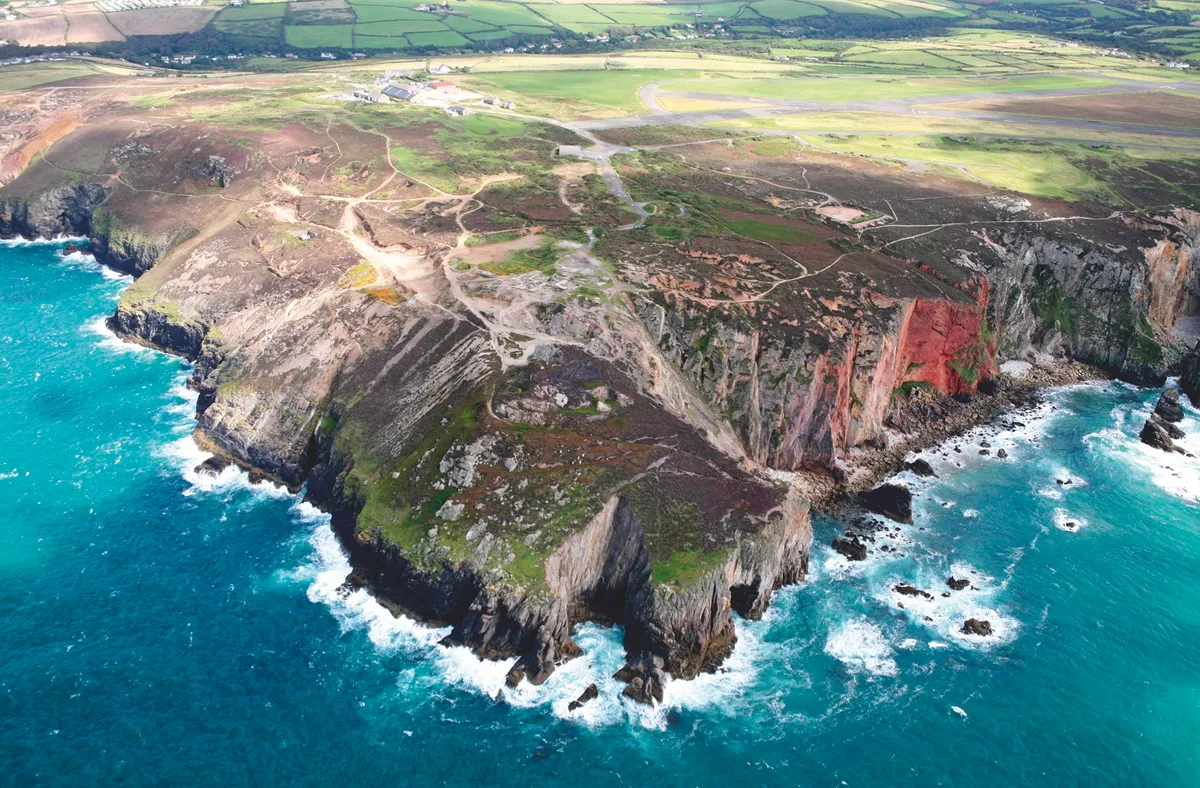
The memorable beauty of north Cornwall’s coastline has won countless accolades, but it is for the industrial relics that stretch between Perranporth and St Agnes that it has been declared a World Heritage Site.
Mining for tin, copper and other minerals has bequeathed a landscape scarred by man and partially reclaimed by nature – all utterly fascinating to explore.
Journey along the spectacular system of cliffs, sea-stacks and inaccessible coves, over bulging Cligga Head and on to Hanover Cove, named after a ship wrecked here in 1763; its cargo of £53m in gold bullion is said to have never been fully recovered.
Looking back towards Cligga, the cliffs are a palette of green, red, grey and yellow, reflecting the complex mineralogy here. The red cliffs are rich in iron and arsenic, the green is copper. The walk drops into Trevellas Coombe, where low-tide rockpools offer the chance to spot marine treasures.
Cligga Head walking route and map
Grey Mare’s Tail, Dumfries and Galloway
2.7 miles | 2 hours | moderate
The Grey Mare’s Tail is one of the country’s grandest natural wonders. In a thundering cascade, this magnificent waterfall plunges more than 60m through a dramatic gorge. It also offers a rare opportunity to observe the peregrine falcons that nest in the nearby crags.
Park at the Grey Mare’s Tail car park then follow the path up a series of stone steps, climbing steeply yet steadily alongside the northern wall of the gorge. Almost immediately you gain amazing views to the majestic waterfall. As the ground flattens the footpath enters the wide hanging valley of Tail Burn to the shore of hidden Loch Skene. The loch contains a thriving population of vendace, Britain’s rarest freshwater fish.
Beyond this point, the landscape is largely pathless and much wilder. If you’re carrying on into the hills you should have a map, compass, waterproofs and solid boots. Otherwise, the loch makes for a perfect picnic spot, with the added relief of a downhill return.
Nearby Moffat, 10 miles to the west, was the first ‘walkers are welcome’ town in Scotland and makes the perfect base for year-round exploration of the peaks and valleys of the Southern Uplands.
Grey Mare’s Tail walking route and map
Wicken Fen, Cambridgeshire
2.8 miles | 1.5 hours | easy
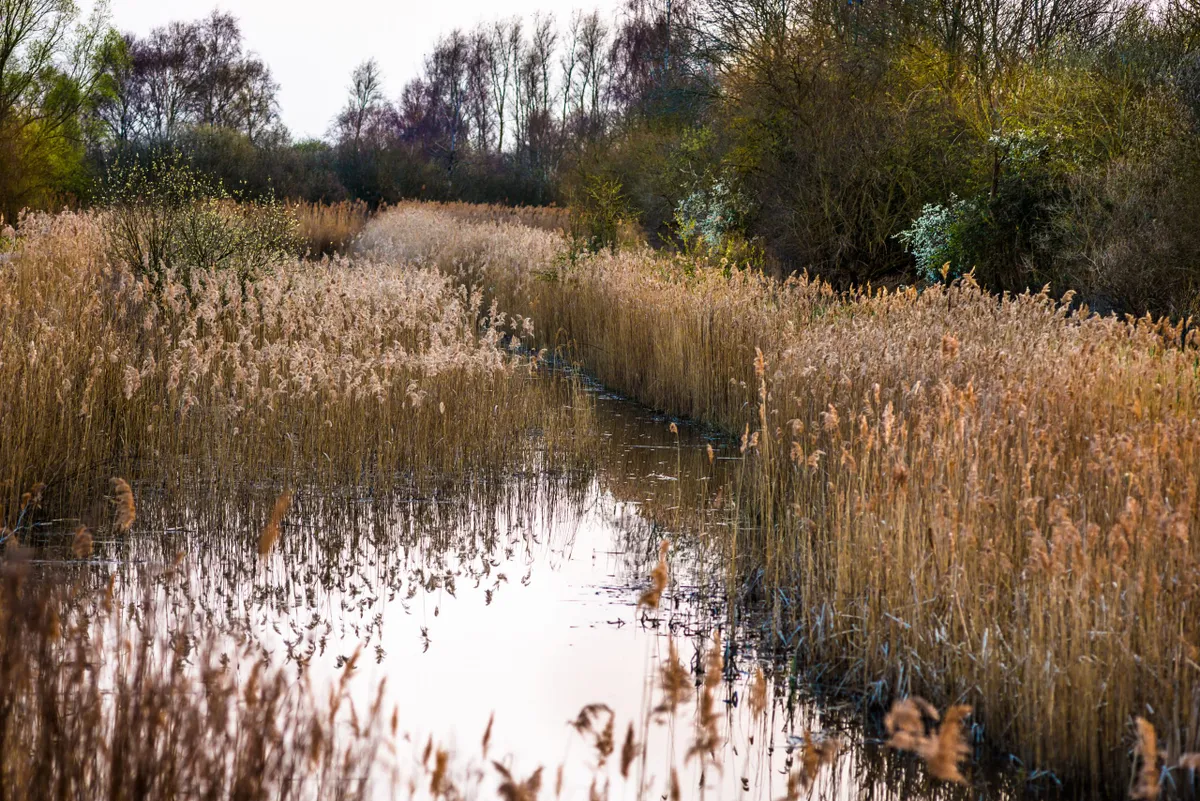
One of Britain’s oldest and most diverse nature reserves, Wicken Fen – a unique remnant of un-drained fenland – is made up of woodlands, wet grasslands, marshlands, bogs, meadows and shallow ponds.
More than 9,000 species have been recorded at Wicken Fen, including rare butterflies, threatened birds such as bitterns and cuckoos, and scarce orchids. Lily pads float on the water, frogs come and go, and you might see water voles, grass snakes and newts.
Pause on the 2.8-mile Adventurers’ Trail to absorb the views, which stretch for miles across acres of marshes and wetlands, surrounded by scrub, fen plants and trees, before exploring the reserve on a series of wooden walkways and waterside paths.
Wicken Fen walking route and map
Hanging Grimstone Wold, North Yorkshire
8.6 miles | 5 hours | moderate
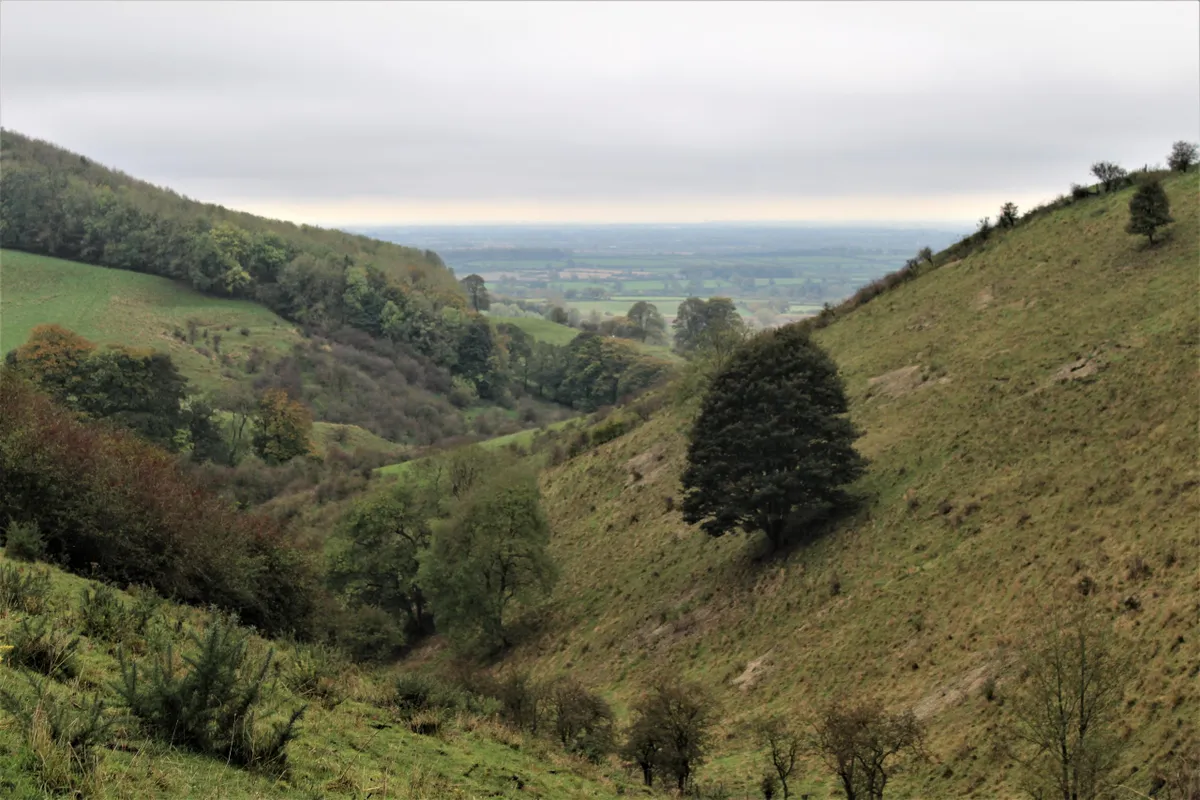
The Yorkshire Wolds encompasses well over 120 deep glacier-formed dales, dotted with isolated farmhouses and tiny villages. Many of these settlements were in existence before the Doomsday Book and are not much bigger now than they were then.
You will encounter some of these places on the Yorkshire Wolds Way, but there are many more great walks off the beaten track in the Yorkshire Wolds, including this moderate-level route through Thixen Dale, Hanging Grimstone Wold and Water Wold.
Hanging Grimstone Wold walking route and map
Mersea, Essex
3.5 miles | 2 hours | easy
Covering roughly seven square miles, Mersea Island off the coast of Essex is the UK’s most easterly inhabited island. Evidence of a pre-Roman settlement has been found here, and legend has it that a Roman centurion haunts the Strood, the road that links the island to the mainland.
It’s a land of two halves: you’ll find restaurants and cafés in West Mersea, offering the oysters and shellfish that the island is famous for, as well as a vineyard selling locally produced wine. While East Mersea is all saltmarshes – where seals exult, sea plants thrive and butterflies dance – fantastic for a stiffly breezy, cobweb-clearing walk.
It will take you five hours to walk around the whole island, but if you’re looking for a shorter route, a circuit around Cudmore Grove Country Park and its environs is ideal.
Mersea, Essex walking route and map
Llyn y Fan Fach, Carmarthenshire
3.8 miles | 2.5 hours | moderate
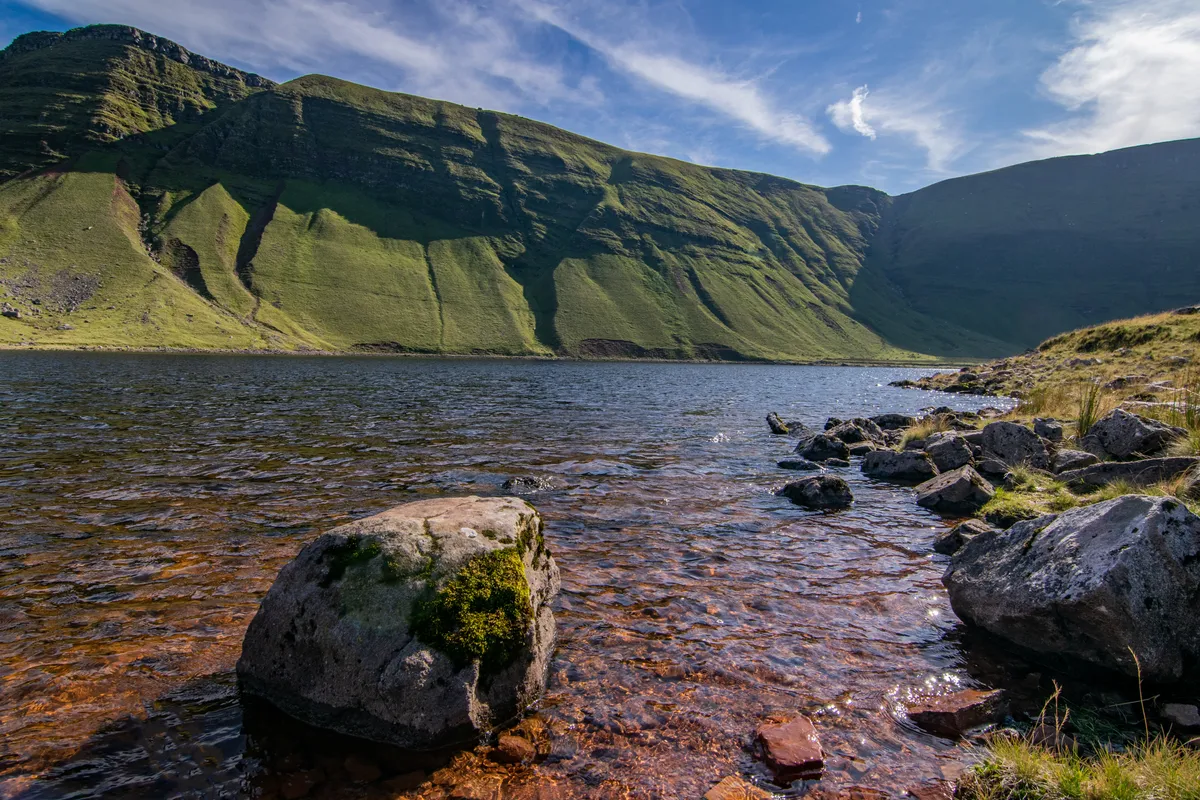
Parking up in the gravel car park just beyond the small community of Llanddeusant, you’ll already be aware of the solitude of this part of the Brecon Beacons. The Black Mountain range is the quiet understudy to the neighbouring central peaks of Pen y Fan, Corn Du and Cribyn – it’s just as spectacular and, without question, wilder.
A four-mile walk follows the bustling Afon Sawdde along the lower branch of the Beacon’s Way to a lonely llyn. It then climbs to the upland branch of the Beacon’s Way before descending on a dramatic ridge back to the car park.
Llyn y Fan Fach walking route and map
Best walks for perspective
Yr Eifl, Gwynedd
4.5 miles | 3 hours | challenging
Mountainous in spirit if not in height, Yr Eifl is a hill of vertiginous vistas and igneous granite intrusions. Its craggy summits have various names but are referred to here as Garn For, Garn Ganol, and Tre’r Ceiri, and this walk scales all three, offering walkers the chance to gaze across the vast waters of the Irish Sea, obscured now and then by reefs of pulsing clouds
The first two peaks are a bit of a scramble – for an alternative, lower route, a valley path skirts the valley to the north and east of the mountains.
Skirrid, Monmouthshire
3.5 miles | 2.5 hours | moderate
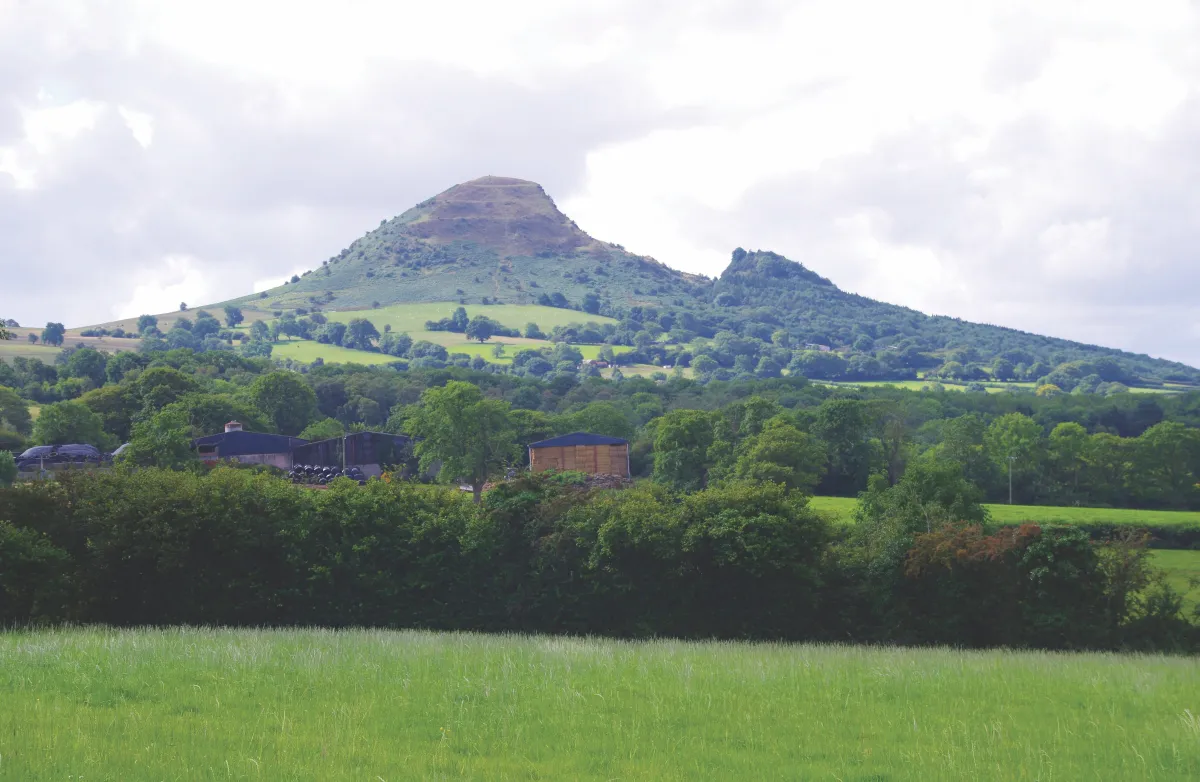
Holy Mountain, Sacred Hill, Ysgyryd Fawr in Welsh – ‘ysgyryd’ meaning shattered or split – or simply The Skirrid, this mini mount goes by many names, hinting at its extensive and intriguing past.
The land surrounding the hill has long been considered holy and fertile – according to one ancient legend, a powerful landslide hit it the moment Christ was crucified on the cross – and religious pilgrimages have been made to the summit for centuries. Enjoy a 5km circular walk to the summit of this spooky hill, which offers dramatic views across the surrounding countryside with the Blorenge hill in the distance.
The Skirrid stands at 486m, but the route’s relatively short distance means the journey can be done in a morning. Stop for lunch at the equally notorious Skirrid Mountain Inn (see box), the site of many a ghostly encounter. You can also stay a night, if you dare.
The path climbs through Skirrid Wood then passes the ruins of an Iron-Age hill fort. As you reach the end of the ridge, take a grassy footpath to the right and begin the steep ascent to the summit trig point, passing the remains of St Michael’s Chapel, which dates to the medieval era. Sugar Loaf and Blorenge can be viewed from the peak, along with the market town of Abergavenny.
Embleton Bay, Northumberland
10.8 miles | 5 hours | moderate
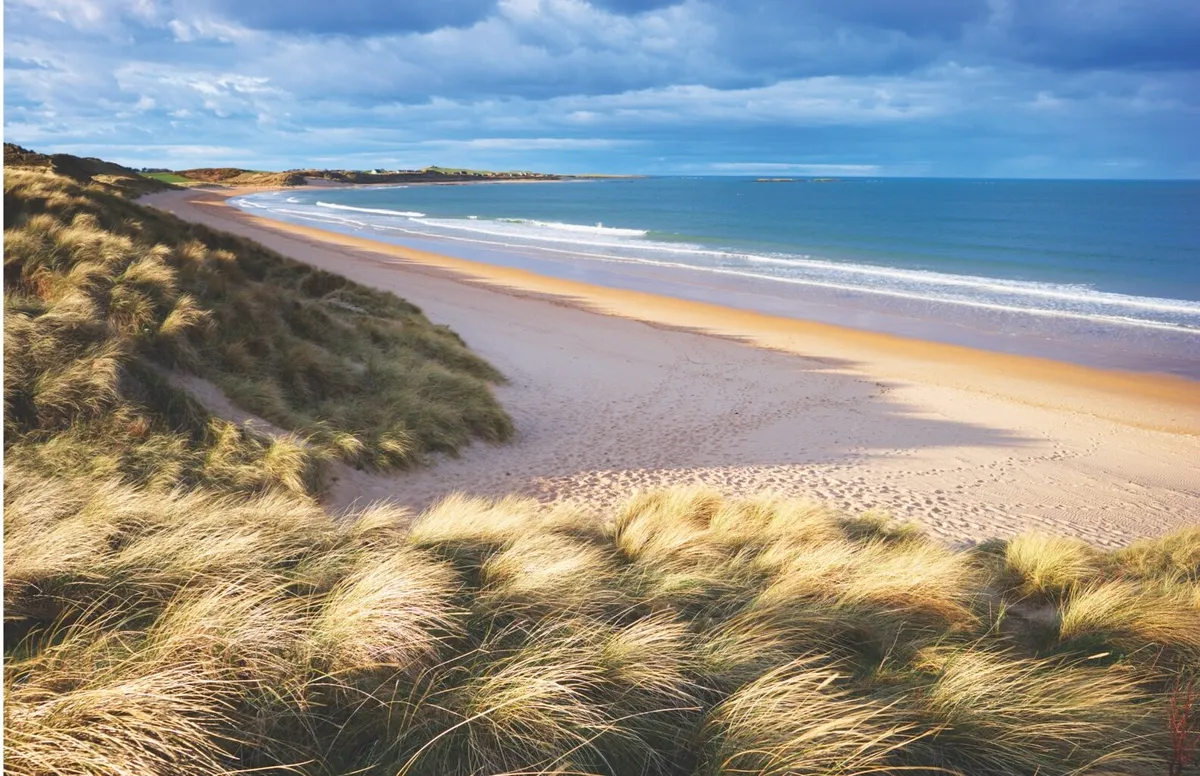
The glorious, golden sands of Embleton Bay deservedly won BBC Countryfile Magazine’s Beach of the Year in 2017. Yet despite the accolades, Northumberland’s beaches are rarely crowded. Even on a beautiful summer’s evening you will often have the place to yourself.
The dramatic sweep of this bay leads to the ruins of 14th-century Dunstanburgh Castle, perched on the dolerite rocks of the Great Whin Sill. While at the northern end of the beach, the white-washed cottages and historic pub of Low Newton-by-the-Sea, an 18th-century fishing hamlet, gather cosily around a village green.
Feel the ocean breeze as you stroll barefoot over ruddy-gold sands, across babbling coastal burns and through wind-shaped dunes to the dramatic ruins of a 14th-century keep.
Embleton Bay walking route and map
Seven Sisters, East Sussex
3.7 miles | 2.5 hours | moderate
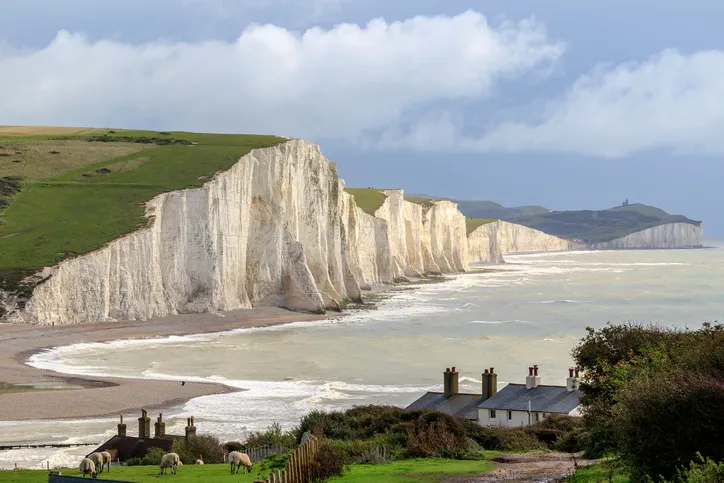
The sea’s aroma sits strong in the air at the National Trust hamlet of Birling Gap. From the top of the steps above the beach and its shelf of shimmering rockpools, the views of the Seven Sisters and Seaford Head are excellent. Many consider these enormous chalk cliffs to be even more picturesque than the celebrated White Cliffs of Dover up the coast.
Leaving Birling Gap behind, a splendid walking route follows the South Downs Way along the verdant cliff tops, where the contrast between the tiny, nodding coastal flowers that pepper the chalk grasslands and the enormous horizon before you is stark.
The route ends at Exceat, where travellers can catch a bus back to Birling Gap from the A259.
Seven Sisters walking route and map
Tegg's Nose, Cheshire
7.5 miles | 5 hours | moderate
Just 20 miles from Manchester city centre, the precipitous Tegg’s Nose Country Park represents an abrupt end to the Cheshire Plain, with flat fields replaced by a whole new, wild landscape of steep, craggy hills, open moors and dense, impenetrable forest.
As you walk this 7.5-mile route through a rich mix of habitats, look for buzzards circling overhead, scanning the fields for carrion, and listen for the unmistakable cronking of garrulous ravens, as well as the piping trill of skylarks as they soar upwards.
Between May and August, the meadows are covered with a carpet of yellow mountain pansies, interspersed with common spotted orchids and yellowy green clusters of flowers atop lady’s mantle – all calming antidotes to a busy mind.
Tegg's Nose walking route and map
Traeth Mawr, Glamorgan
4.8 miles | 3 hours | moderate
Leaving the settlement of Monknash, once the site of a monastic grange, this south Wales route passes through the steep-sided, river-cut vale of Cwm Nash. Descending, the rhythm of the river becomes stronger, the smell of earth more potent.
Gradually, the trees yield to a mass of gnarled blackthorn and almond-scented gorse, then the river breaks from the scrub and spills out across a series of shallow platforms into the churning waters of the Bristol Channel. Huge Lego-like cliffs rise to the north and south. On a windy day, the lumbering surf slumps hard on to the shore, rumbling like thunder across the boulders on its retreat to the sea. The path then rises on to the cliff tops,
Traeth Mawr walking route and map
Rame Head, Cornwall
6.8 miles| 4 hours | moderate (one way)
This stunning section of the South West Coast Path leaves Plymouth behind for the wilds of Rame Peninsula AONB. Stroll through woodlands budding with wildflowers and along sandy bays to historic Kingsand and Cawsand, before reaching spectacular Rame Head.
Rame Head along the high cliffs. Revel in the wild open space of the nearing headland, dotted with wild ponies grazing the rich coastal grasses.
Climb the snaking steps to St Michael’s Chapel and walk to the end of the headland. On a clear day, you can see the famous Eddystone Lighthouse offshore. Listen to the soothing buzz of busy pollinators and the unmistakable metallic chirp of the stonechat.
Soak up the panoramic views and enjoy a picnic before your return. Or, if a relaxing slap-up cream tea back in Kingsand and Cawsand appeals, there is a regular bus service from Kingsand back to Cremyll and the ferry.
Rame Head walking route and map
Broadway Tower, Worcestershire
5.2 miles | 3.5 hours | moderate
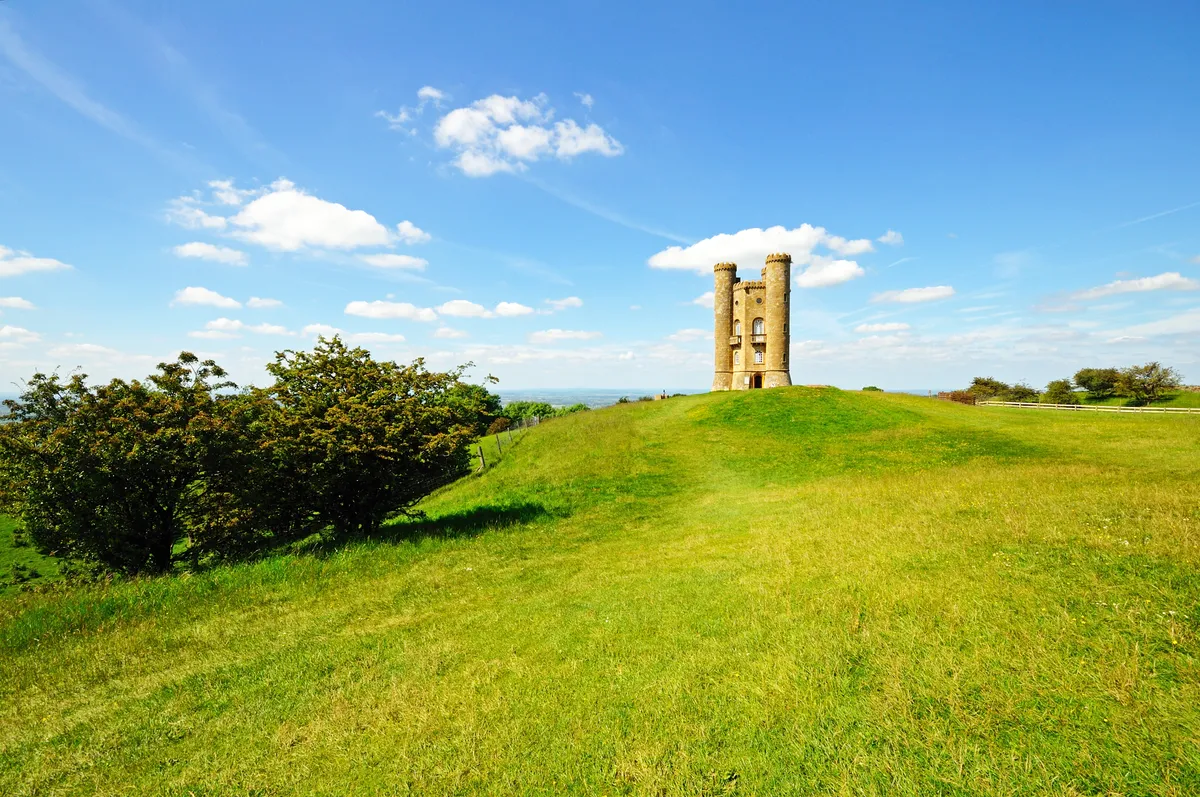
The picturesque village of Broadway, with its warm, honey-hued cottages, is the perfect base for a Cotswold stroll. Take time to meander along the high street past pubs, cafés, tea rooms and shops – offering art and antiques, country clothing and gifts – then head up onto the hills where views from Broadway Tower stretch out over the Severn Valley and the Vale of Evesham, with the Malverns in the distance, while ever-present in the valley below is Broadway itself.
Broadway Tower walking route and map
Rockcliffe and Kippford, Dumfries and Galloway
4 miles | 2 hours | moderate

The stretch of Rough Firth, between Kippford and Castle Point, where Urr Water meets the Solway Firth, is blessed with a variety of habitats. Ancient broadleaf woodlands burst with wood anemones and bluebells; well-tended meadows erupt with daisies, dandelions and insect-friendly grasses; and vibrant yellow gorse flowers line the coastal headland like floral beacons.
There are numerous viewpoints from which to survey this colourful landscape: The Muckle’s gorse-topped summit, 100m above sea level, is ideal for little legs; the small peak of Mote of Mark is the perfect prelude to a picnic in the flower meadow below; and then there’s Rough Island (accessed only at low tide and closed in May and June to protect ground-nesting ringed plovers and oystercatchers).
Rockcliffe walking route and map
Causeway Coast, Co Antrim
10.5 miles | 5–6 hours | moderate
It would be hard to conceive of a shoreline more varied and dramatic than Antrim’s Causeway Coast. Each mile brings a change of scenery, a new natural attraction to admire. Some sites are so celebrated that they buzz with summer tourists, but few people divert on to the coastal path that links them all together. All the better for walkers, who can appreciate the real atmosphere of the area, uninterrupted by human distraction.
The best section of the waymarked Causeway Coast Way starts at the thrilling Carrick-a-Rede Rope Bridge, then traces the shoreline west past sandy beaches, secluded harbours, sheer cliff tops and historic landmarks. Finish at the famous 40,000 hexagonal columns of Giant’s Causeway. The Causeway Rambler and Antrim Coaster offer a return bus for tired walkers.
Dover to Deal, Kent
9.9 miles | 5 hours | moderate
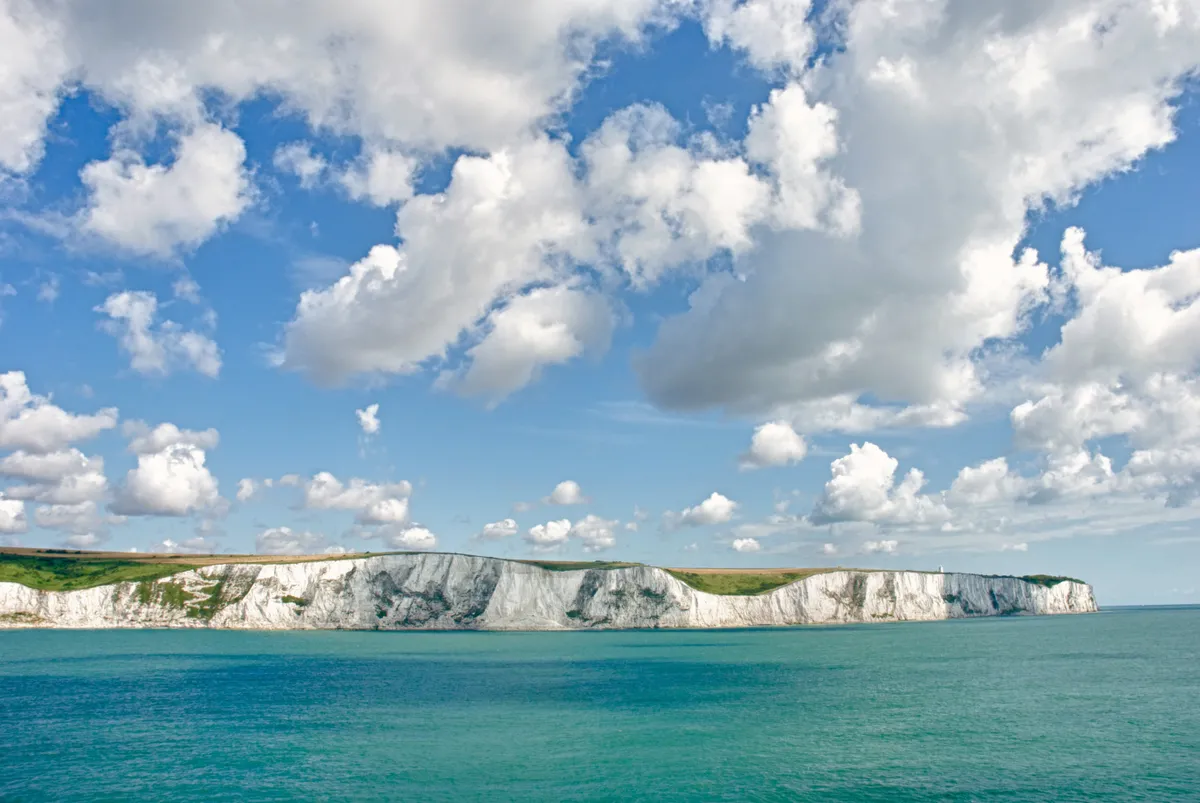
A bright August afternoon, 55BC. Shingle crunches beneath sandals as Julius Caesar’s scouts slip from their boats and head up the beach. This was a reconnaissance mission, to decide if England was worth invading; they concluded it wasn’t. Or at least, not yet – 12 years later they returned, this time with a good deal more conviction and legions.
The Kent coast has been England’s front line for millennia, and as this straightforward 10-mile walk takes you over the cliff tops and beaches between Dover and Deal, its past unfolds, revealing a fear of attack that stretches from the Iron Age to the Second World War.
Dover to Deal walking route and map
Tentsmuir, Fife
5.7 miles | 3.5 hours | moderate
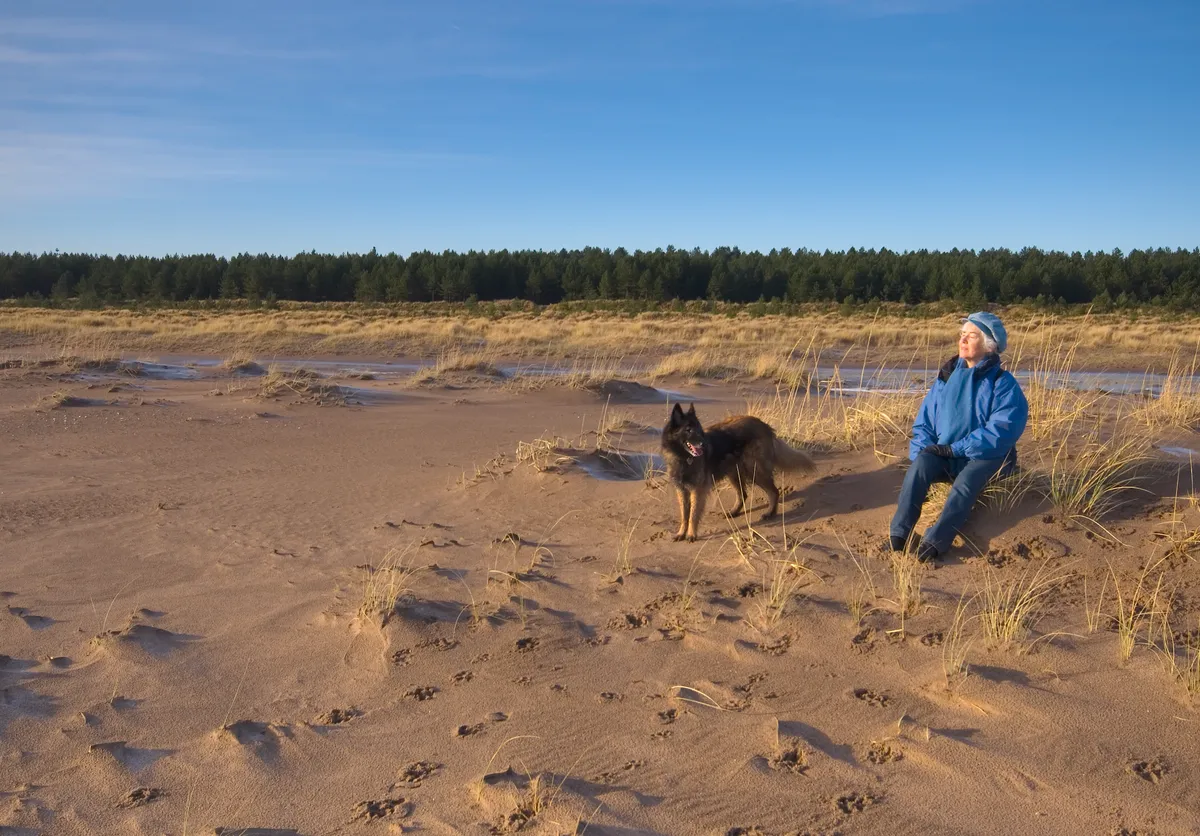
Tentsmuir is situated at the southern edge of the Tay estuary on Scotland’s east coast, and during the war its extensive sands were at great risk of an invasive landing. Defending its beaches was crucial, and lines of concrete anti-tank blocks, observation towers and pillboxes, all designed to slow down enemy movement inland, were constructed in the surrounding forests.
Nowadays the woods are a tranquil haven of Scots and Corsican pines, home to roe deer and red squirrel. Follow the Seashell Trail waymarkers from the car park along the edge of the forest.
Tentsmuir walking route and map
Birchover, Derbyshire
5.3 miles/8.6km | 3 hours | moderate
Surrounding the Peak District village of Birchover is a haunting landscape of gritstone bluffs, standing stones, burial mounds and Bronze-Age stone circles, hidden in inky woodland or exposed on windswept upland.
The paths here are littered with the history and mythology of the south-east Peak, from the hermit of Cratcliffe Tor who led travellers to safety off the ancient Portway trail, to the notorious outlaw who leapt across the soaring pillars that straddled Robin Hood’s Stride. Rowtor Rocks tells a story of prehistoric rock art and Victorian sculpture, while Stanton Moor reveals 4,000 years of human activity.
Birchover walking route and map
Dollar and King’s Seat Hill, Clackmannanshire
6.5 miles/10.4km | 3.5 hours | moderate
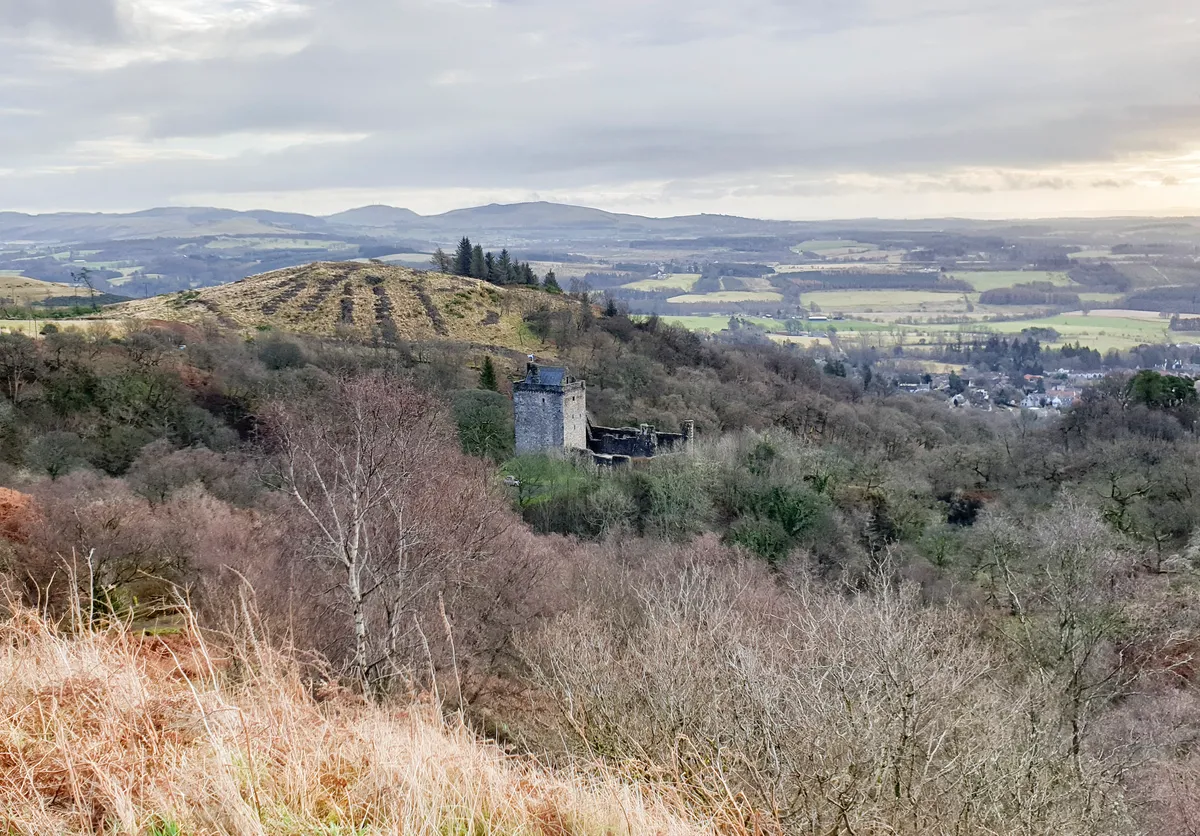
The steep southern scarp face of the Ochils in central Scotland stands in sharp relief to the surrounding flat lands, giving these grassy, rounded hills a deserved reputation for drama. Although popular with local hillwalkers, this range is largely neglected by visitors from elsewhere. Come walking here, though, and you’ll find a number of satisfying routes with extensive views and plenty of peace and quiet.
This walk – a lovely and gentle introduction to a prominent Ochil peak – leads via the deeply gouged Dollar Glen up to the 648m (2,125ft) King’s Seat Hill.
